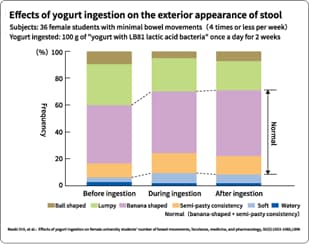|

Effect of yogurt on constipation
Consumption of yogurt made from LB81 lactic acid bacteria* improved the subjects’ gut health as measured by the number of times stools occurred, as well as their volume and shape.
In a joint research study conducted by Meiji Co., Ltd. and the Faculty of Life and Environmental Sciences at Showa Women’s University, female subjects around the age of 20 -- a demographic typically experiencing chronic constipation -- were fed yogurt made from LB81 lactic acid bacteria to observe if there was any correlation between the amount of yogurt consumption and stool regularity.
The study showed that the yogurt consumption had overall positive effects on the subjects’ stool patterns: higher stool frequency, increased volume, normalized shape, etc.

|
 |
Before this study, a questionnaire survey to recruit subjects was conducted of female students aged between 18 and 21, to which 170 responded (with 82.4% reporting a stool frequency of four times or less per week; see Figure 1); from this pool, 106 were selected to participate in the study. While the group included both constipated ones (with a stool frequency of four times or less per week) and ones with normal stool patterns (with a stool frequency of five times or more per week), they were randomly divided into two groups, one of which consisted of 50 subjects that were given 100 g of yogurt per day, while the other group consisted of 56 subjects that were given 250 g of yogurt per day. The study lasted for six weeks, during which the subjects were continuously fed yogurt made from LB81 lactic acid bacteria. |
|
Every time a stool occurred, each subject was asked to record the details on a questionnaire survey form, including ①stool frequency (number),② volume, ③visually observed shape,④color,⑤odor, ⑥and a description of the sense of relief felt after passing stools.
After the records were tallied, it became apparent that for ①stool frequency the subjects experienced an increase as they ate the yogurt made from LB81 lactic acid bacteria (Figure 2), while②their stool volume also increased. Those increases were more pronounced among the subjects that were constipated upon joining the study (stool frequency of four times or less per week).
|
 |

|

|
 |
As for ③visually observed stool shape, the occurrence of banana-shaped and semi-pasty stools increased significantly, which are both considered optimal stool shapes. The softening of stools was observed not only with the constipated subjects but also with the subjects with normal stool patterns (stool frequency of five times or more per week) (Figure 3). As for ④color and⑤odor, no change was observed. Concerning⑥sense of relief felt after passing stools, the perception improved among the constipated subjects. In each of the surveyed items, there was no significant difference between the two groups that were fed 100 g and 250 g of yogurt daily.
*The yogurt made from LB81 lactic acid bacteria that was fed to the subjects in the study was a plain yogurt fermented with Lactobacillus delbrueckii subsp. bulgaricus 2038 and Streptococcus thermophilus 1131.
|
Daily consumption of yogurt made from LB81 lactic acid bacteria* effectively improves stool regularity.
As explained above, the study proved that yogurt made from LB81 lactic acid bacteria improves stool regularity and increases stool frequency and volume. The yogurt also apparently reduces the occurrence of stools that are either too hard or soft, in addition to improving the sense of relief felt after each stool, especially among constipated persons.
It is also noteworthy that consuming more yogurt does not necessarily lead to further improvement, as the subjects that consumed more than 100 g of yogurt per day all showed similar results. So if you want to improve stool regularity, it might be worth eating at least 100 g of yogurt made from LB81 lactic acid bacteria each day.
|






